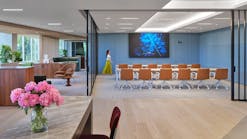Sapphire 2020 winners tackle quality of experience (MAGAZINE)
The sixth annual LEDs Magazine Sapphire Awards proceeded in a more unusual fashion than in the past several years. There were no blue carpets rolled out, but guests did roll up to the harbor in San Diego. There was no formal attire, but the tread of sensible shoes allowed attendees to walk the aircraft carrier Midway, find inspiration in the historic museum exhibits, and steady themselves on the four-acre flight deck to cheer on their colleagues as the LED and solid-state lighting (SSL) industry gathered to learn who would walk away with honors during the reception on Feb. 12, 2020.
Back in our January/February issue, we published the full list of finalists in 17 technology categories as well as the finalists for the Illumineer of the Year. The timing of the announcement in January was intended to provide a fresh wave of optimism and well-deserved recognition for the innovations that were launched in the prior year, showing that the LED and SSL market has plenty of drive to succeed in evolving to a valued technology field rather than a commodity-product supplier model.
Also in our January/February issue, chief editor Maury Wright observed in his Commentary that light quality is one of the biggest issues facing the industry now that energy savings is no longer the major driver of SSL product development. In fact, industry insiders have been making the case for some time that the first wave of LEDification has passed, and it is time to focus on refinement of design, more integrated technology and development against performance metrics that account for light quality as appropriate for the application in which the product is intended to be used.
The Sapphire Awards reception marked a new era in fulfilling the mission of SSL to deliver on the digital controllability, flexibility in form factor, and quality of light inherent in the LED source. Throughout the night, our team and colleagues admired the breakthroughs in LED, controls, and component technology that have enabled big ideas to become reality in the form of SSL end products and complex integration systems. Guests were greeted aboard the USS Midway, now established as one of the premier museum attractions in the United States. In keeping with the theme inspired by “mavericks” in technology, this opening ceremony video (below) shows the Sapphire finalists as “top guns” in the industry (yes, we had a certain classic 80s movie for inspiration). The Sapphire Award winners received their accolades and trophies later in the evening, establishing themselves as innovators marching the LED and SSL industry forward into the next phase of technology application. We will have more multimedia from the Sapphire Awards available soon.
But the industry hasn’t reached the pinnacle. The top innovators this year will only push everyone to strive harder to reach new levels of business and engineering success. And with that, let’s find out what makes a Sapphire winner worthy of the honors.
Illumineer of the Year
As we have seen across the industry, there is a push toward creating the experience of natural light within the built environment. More and more, spectral power distribution (SPD) enters the discussion, using technology to reproduce the changing color temperature and intensity of sunlight. Within the past couple of years, Cree Lighting has worked toward that goal with dynamic daylight-cycle luminaires and the SmartCast controls platform, resolving into what is now commercialized as the Cadiant Dynamic Skylight. Back at LightFair International 2018, the Cree booth featured a demonstration area with a skylight concept it was calling Arcadia, which delivered changing light conditions using a planar optic structure. In 2019, Cree Lighting launched Cadiant, driven by software and physical controls that allow two separate “sun and sky” LED panels — one to imitate the sky’s shifts in blue and gray and one to mimic the warm and cool color temperature changes of daylight from east to west. Kory Liszt and Bob Rogers, both software engineering managers with Cree Lighting, led the software development for the Cadiant Dynamic Skylight, which delivers the dynamic lighting experience from the soft, warm glow of sunrise through a dazzling afternoon sky to a warmer, calming evening scene.
Packaged LEDs and OLEDs
Maintaining that daylight and human-centric lighting theme, the winning product in the Packaged LEDs and OLEDs category was specifically designed to feature a higher level of cyan energy to influence human circadian rhythms. Nichia’s Vitasolis LED was also engineered with a broader spectrum to reduce eyestrain and improve eye response for visual acuity, and a suppressed yellow spectrum to produce a crisper white light output. As the company noted in its submission materials, “The SSL industry has evolved significantly. However, it is in a transition phase from an ‘Energy Savings’ story to a ‘Quality of Light’ story,” and we couldn’t agree more. In fact, three members of the product development team at Nichia — Shinya Matsuda, Naofumi Sumitani, and Koji Kajikawa — were nominated for the Illumineer of the Year based on the Vitasolis and other recent high-performance LEDs released within the past year with light quality features such as high color rendering index (CRI) given a priority focus.
Tunable White LEDs and Light Engines
Tailoring light output for the purpose of the environment is becoming a necessity rather than a luxury for designers and specifiers. Since acquiring Lumenetix in mid-2019, ERP Power has added tunable lighting and related controls to its LED driver portfolio, including the LTM3 tunable color light engine. The LED light engine is driven by the araya5 Logic & Power Module (ALPM) to deliver between 1000–1500 lm/ft and produces a tuning range from 1650–8000K at <2 MacAdam ellipse color consistency, with 90+ CRI for excellent color quality. With the module, the linear tunable color arrays, featuring five color mid-power LEDs, can be dimmed down to 0.1%. The granularity of control and multiple connectivity options (Bluetooth Low Energy and Mesh alternatives, plus 0–10V, DMX512-A-RDM, DALI Type 8, Lutron EcoSystem, and Wattstopper DLM compatibility) enable broad usage across spaces as diverse as healthcare facilities, commercial buildings, historic sites, hospitality venues, and more to enable a flicker-free, natural-daylight emulation experience.
LED Drivers
Some LED driver winners in the past few years have been eyed for integrating smart features for connected lighting, but we cannot overlook the main objectives of an LED driver to convert stable power for the light sources and safely control the power load within the SSL end product, preventing failures and overvoltage situations that can damage the delicate electronics or worse, become a hazard. Inventronics was a Sapphire 2018 finalist with its ESD-600S driver. This year, the company’s EUM-DT gained recognition as a compact LED driver with patented surge protection of 6 kV DM and 10 kV CM to prevent failure in the case of transient events. The driver enables faster time to market as a higher-power UL Class P option. IP66 and IP67 ratings allow for use in harsh environments, and the circuit design allows luminaire hipot testing during production.
SSL Enabling Technologies and Test
The innovations among our submissions likely would not hit the market without proper test and measurement before they launched. LED source characterization,
according to an article written by Vektrex CEO Jeff Hulett in 2017, must rely on newer test methods that don’t create unnecessary heat effects, which throw off the results when testing high-efficacy LEDs. Vektrex has crafted its SpikeSafe series of pulsed source measure units to, well, source pulsed current and measure voltage simultaneously. The winning 10A SpikeSafe SMU provides accurate pulsing down to 1 μs with thousands of watts of configurable and sustained power. On-the-fly pulsewidth correction and short, uniform pulses reduce device junction heating, enabling more reliable IV curves to be generated for LED characterization. More accurate data helps SSL product developers reduce R&D costs and improve the reliability of the end product.
Emergency SSL Luminaires, Modules, and Drivers
Emergency lighting systems are a very particular beast. Aside from building codes and the demands on a system running at a reduced capacity, emergency lighting components need to be designed with a new level of robust features especially in the era of smart buildings. Igor’s Nexos Linear Network Node – Max offers Power over Ethernet (PoE)-based data communications and power distribution capability for building systems, while being UL 924-FTBR listed for use as an emergency LED driver. But going beyond the full range of dimming and white-tuning capability, the node also features USB connectivity for external devices, such as Bluetooth and wireless sensors, that can communicate via Igor’s Internet of Things (IoT) platform. The node, says Igor, is compatible with all other manufacturers’ devices and allows all the components in the lighting system to be controlled and collected data to be analyzed with the Nexos software and cloud services.
Smart and Connected SSL Enabling Technologies
Connected residential lighting is growing in demand, as are technologies that simplify the number of devices required to control the lighting. Samsung Electronics offers the ITM-Resi, a wireless smart-home connectivity module that removes the hub from the equation, if desired, and combines Bluetooth Low Energy and Zigbee connectivity into one device. The company’s SmartThings platform supports an extended list of interoperable devices from partners in lighting and home automation, including voice-controlled home assistants — all of which can be controlled via a single app with the customizable app plug-in.
Smart and Connected SSL Systems
The Signify Advance FlexTune system connects a lot of dots we’ve written about lately. The tunable lighting capabilities, enabled by a two-channel Advance Xitanium FlexTune SR LED driver, bring human-centric lighting to commercial, hospitality, healthcare, and education environments. The Sensor Ready (SR) designation, as we reported in a feature on driver architectures, indicates a two-wire interface based on an evolved version of DALI (Digital Addressable Lighting Interface) that carries power and data over the same wires. Adding on two Fortimo LED strip PR LV5 FlexTune modules with daisy-chaining capability, as well as Zigbee-based Philips EasySense sensors, the Flextune system offers simple setup of smart, tunable lighting that works with other thirdparty SR-certified networked lighting control (NLC) devices for power metering, monitoring, and diagnostics, and localized or remote control.
SSL Flex, Tiles, and Sheets
LED lighting in form factors such as flexible strips, tiles, and sheets bring the true customizability of SSL to lighting designs, especially those that require the materials to conform to a surface or to be embedded in the architectural design. The fully-dimmable NEXUS ultrahigh-definition Flex tape from LED Linear USA is reportedly the first LED tape lighting to feature tiny chip-scale package (CSP) LEDs. CSP LEDs have been penetrating the market slowly, in part due to requiring different manufacturing steps than more conventional surface-mount device (SMD) packaged LEDs. But their small footprint allows LED Linear to pack many LEDs onto its thin, flexible circuit board. The 150° light emission and active current-regulation IC technology enable uniform white-light output along the tape, with CCT options from 2200–6500K at 95 CRI and R9 of 75 for excellent light quality.
SSL Lamp and Retrofit Designs
If there is a retrofit lamp that doesn’t get enough appreciation, it is perhaps that which is intended for harsh, industrial environments. However, it’s precisely
the inhospitable conditions that demand higher expectations. eLumigen has produced rough-service A19 lamps with up to 120-lm/W efficacy and a high power factor of 0.98 with low inrush current, while ensuring that the lamps can maintain performance claims in enclosed fixtures with its 40W, 60W, 75W, and 100W-equivalent replacements. The A19 form factor was selected to fit across a variety of light fixtures. The innovation is in the combination of available CCTs — which include 2000K for poultry-raising applications — along with the ruggedness, low-EMI, and wet listing. Altogether the lamps provide glare-free, flicker-free, and reliable light safely in rough commercial and industrial scenarios.
Indoor Decorative and Pendant SSL Luminaire Design
There are plenty of striking LED luminaires to grab attention or to blend into any design aesthetic. But few that we’ve seen have the seemingly incongruous combination of complex-looking configurations and simplified installation exhibited by the Arena 8200 by Eureka. The luminaire is composed of a magnetic ring onto which the installer can snap multiple LED light source accessories, with a total load up to 100W. Slice, Aim, Beam, and Glow models offer linear, projector, and decorative light styles. The light sources provide various diffuse, aimable, direct, and indirect illumination options with multiple CCTs and typical CRI of 85. They can be mixed and matched for truly customizable luminaires to suit the purposes of each area or space. The magnetic mounting eliminates the need for tools and enables the user or designer to modify the modular luminaire at any time.
Indoor Troffer, Track, and Downlight SSL Luminaire Design
The theme of flexibility is demonstrated many times over in this year’s winning Sapphire Awards products. In some applications, architectural lighting needs to blend in while allowing other items in the built environment to stand out. Glint Photonics says its Hero luminaire opens up the possibility of use as a downlight, tracklight, cove, or recessed luminaire due to its patented, field-adjustable LightShift optics. The unassuming face of the luminaire features a small joystick for fingertip adjustment, and beam direction is modified without a tilting mechanism, eliminating the need for additional glare mitigation accessories, which can help reduce costs. Its design is suited to high-end retail, museum, gallery, and showroom spaces where the light sources need to blend in yet distribute light exactly where it is needed.
Industrial SSL Luminaire Design
Again, with a workhorse product, elegance of design is in the operational details. Plug and play, out-of-the-box functionality using a mobile app, multi-tiered network security — these are terms not typically associated with industrial lighting. However, Cooper Lighting Solutions has gone the extra mile to develop an entire networked system for heavy-duty commercial and industrial use, the Metalux Industrial WaveLinx wireless connected lighting system. Back at LightFair 2017, then-Eaton Lighting launched the WaveLinx technology with its first mesh-based auto-commissioning system. Now Cooper Lighting Solutions after an agreement was struck to be acquired by Signify, the company has expanded with integrated industrial sensors on Metalux industrial high bays, with field replaceability. The IP66-rated networked system can be scaled up from the room level to multiple buildings on a campus, collecting and analyzing data for light levels, occupancy, device status, and power consumption across warehouses, factories, and other industrial spaces.
Outdoor Landscape and Architectural SSL Design
A 2017 finalist for a previous version of the HYDROLUME 24V striplight, Elemental LED’s Diode LED brand has brought more robust, submersible RGB (red, green, blue) LED lighting to challenging water features such as pools and fountains, and even natural bodies of water. The low-voltage, IP68-rated striplight can be combined with DMX and pulsewidth modulation (PWM) controls when used with constant-voltage drivers. Its protective coating resists UV damage from direct and indirect sunlight. A UL 676 rating means the product is safe for human or wildlife contact when submerged. HYDROLUME strips can be arranged in up to 26-ft runs at the Reno, NV LED assembly site.
Outdoor Street and Area SSL Luminaire Design
Photometrics and light distribution are critically important in outdoor area lighting designs. Outdoor lighting must be carefully placed to avoid dangerous glare near busy roads and walkways, important for both drivers and pedestrians. ANP Lighting’s EQ post-top LED luminaires use light guides to deliver uniform illumination with optical control, and eliminate pixilation of the LED source. Type II, III, IV, and V beam distributions are available in lumen packages ranging from 3000 to 14,000 lm. A range of CCT options includes 2700K, 3000K, 3500K, and 4000K. A flushmount adapter makes installation to the pole easy and eliminates exposed hardware for a cleaner aesthetic. An optional high-low digital passive infrared (PIR) motion sensor complies with California Title 24 requirements for bi-level dimming of fixtures. All around, the post-top luminaire offers style, options, light output, and beam distribution to satisfy a number of lighting schemes that demand safe and comfortable outdoor light.
Horticultural Lighting
Fluence Bioengineering has established itself as an authority on developing horticultural lighting products backed by research. Its SPYDR 2i series horticultural luminaires are bright and flexible for indoor rack lighting to maximize the grow space for improved yields and quality of cultivars, from vegetables to ornamentals to cannabis. SPYDR comes in three sizes and more than 10 mounting options to optimize placement of fixtures in vertical arrangements as well as table configurations for precise, uniform illumination. The luminaire leverages two photosynthetic photon flux (PPF) output levels and integrated dimmability to enable control of photosynthetic photon flux density (PPFD) for specific crops. Average PPFD is up to 1060 µmol/m2/s over a 4×4-ft canopy. Acquired nearly two years ago by Osram, Fluence now has in-house access to a variety of LEDs designed for specific horticultural needs, so we have no doubt we’ll continue to hear the company name behind many innovations to come.
Lighting for Health and Wellbeing
When it comes to healthy lighting, typically folks think of the natural sunlight they’re lacking most days in indoor environments. Given the complex software development achieved by our Illumineers of the Year from Cree Lighting, it comes as no surprise that the company’s Cadiant dynamic skylight won the category of lighting for health and wellbeing. It replicates the natural light levels/intensity and color temperature of the daylight cycle not only with the illumination that it delivers but also with its sun-and-sky scene aesthetics. Cree Lighting’s SmartCast controls can connect with other luminaires to enable scene-setting options tuned to user preferences. The wall-mounted touchscreen features standard presets but also allows manual control over the lighting experience. The luminaire has the potential to bring natural light into spaces that have restricted views and, according to surveys and industry discussions, that is becoming important to office workers’ productivity and wellbeing.
Specialty SSL Design
Finally, sports and entertainment venues bring special challenges in specialty SSL design due to advances in broadcast television. Lighting must be bright and bring good color quality to the field, stadium, or arena, but it must also deliver appropriate visual acuity for the players, with optimal beam placement and glare-minimizing features. Cooper Lighting Solutions’ Ephesus division knows how to make great plays in sports lighting, having illuminated multiple pro sports venues across baseball, American football, and automotive racing, to name a few. Its Sapphire-winning Lumadapt 8 LED sports lighting system brings new future-proofing capability to venue operators now — they can purchase what they need and remotely update and expand the controls. The system can be commissioned using near field communication (NFC) in each light fixture, setting beam angle, CCT, and other parameters. Color tuning and color changing allow custom scene setting for different types of events. The cloud approach brings adaptability and evolution to the system operator.
Congratulations to all the winners and to all who helped make this program possible behind the scenes. Be on the lookout for the call for submissions for the 2021 Sapphire Awards program, coming this July.
2020 Sapphire Awards judging panel
Jim Benya, Benya Burnett Consultancy
Carl Bloomfield, Intertek
Chris Brown, Nextgen Lighting
Deborah Burnett, Benya
Burnett Consultancy
Monica Hansen, LED Lighting Advisors
Eric Haugaard, Cree Lighting
Duncan Jackson, Billings Jackson Design
Brad Koerner, Koerner Design
Clifton Lemon, Clifton Lemon Associates
Steve Paolini, Telelumen
Kris Sandheinrich, KGM Lighting
Wilhem Sillevis-Smitt, Lumileds
Philip Smallwood, Fluence Bioengineering
Aaron Smith, Finelite
Erik Swenson, Nichia
Robert Steele, Strategies in Light
Carrie Meadows, LEDs Magazine
Maury Wright, LEDs Magazine
*Updated Feb. 28, 2020 3:40 PM for Diode LED facility correction.

Carrie Meadows | Editor-in-Chief, LEDs Magazine
Carrie Meadows has more than 20 years of experience in the publishing and media industry. She worked with the PennWell Technology Group for more than 17 years, having been part of the editorial staff at Solid State Technology, Microlithography World, Lightwave, Portable Design, CleanRooms, Laser Focus World, and Vision Systems Design before the group was acquired by current parent company Endeavor Business Media.
Meadows has received finalist recognition for LEDs Magazine in the FOLIO Eddie Awards, and has volunteered as a judge on several B2B editorial awards committees. She received a BA in English literature from Saint Anselm College, and earned thesis honors in the college's Geisel Library. Without the patience to sit down and write a book of her own, she has gladly undertaken the role of editor for the writings of friends and family.
Meadows enjoys living in the beautiful but sometimes unpredictable four seasons of the New England region, volunteering with an animal shelter, reading (of course), and walking with friends and extended "dog family" in her spare time.
Sign up for LEDs Magazine eNewsletters
This monthly digest combines business analysis, research and standards activity toward industry best practices, and technology developments for high-potential lighting applications including health and wellbeing, horticulture/controlled environment agriculture, and connected SSL and controls.























